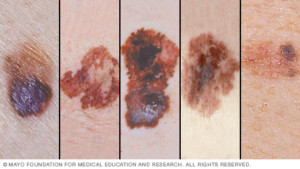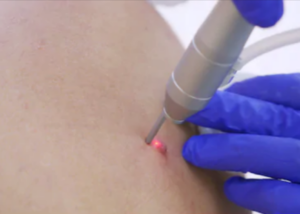
Biopsies for diagnosing melanoma aren’t as accurate as you may believe.
Biopsies for melanoma are not much more reliable than an 85 percent accuracy rate, according to chemistry professor Warren S. Warren, director of Duke University’s Center for Molecular and Biomolecular Imaging.
Warren headed the development of a laser-based tool that has the potential for diagnosing melanoma right in the dermatologist’s office.
This laser tool pumps tiny amounts of energy into a mole that a doctor may suspect is cancerous. The energy redistributes in skin cells, and this gets analyzed.
The Duke researchers discovered that a skin pigment called eumelanin is more prevalent in melanomas than in normal skin tissue.
Based on this, the researchers correctly identified the 11 malignant samples that were among 42 samples in the study.
The next step is to test the laser on thousands of archived slices of skin tissue.
Melanoma biopsies aren’t only less than reliable for diagnosing this disease, but are also capable of generating a false positive.
Warren says that even if the laser tool is only 50 percent more accurate than biopsy, it would actually prevent approximately 100,000 false-positive melanoma diagnoses; that is, normal tissue being diagnosed as melanoma.
A study in the Journal of American Academy of Dermatology (2010) says that pathologists would be in disagreement over whether or not a biopsy sample showed cancer … in 14 percent of biopsies.
A more accurate method of melanoma diagnosis is needed, says Warren, as false-positives result in expensive unnecessary treatments.
This laser tool is currently available commercially.
It just needs to be added to the microscopes that pathologists are already using to diagnose melanoma.
If you’re going to have a mole biopsied because your doctor ways it looks suspicious or because you’ve noticed it changing, you’ll want to inquire about the biopsy process — if the laser tool is in use.
Problem is, the cost to add the laser would be $100,000, but would more than offset the cost of unnecessary treatments for over-diagnosed cases of melanoma.
A more advanced step would be to develop the laser so that it can diagnose melanoma without the skin lesion even being removed from the patient.
This would be even more expensive than the tool being added onto a microscope, and this technology won’t be available for a few years, says Warren.
However, to get to that point, researchers plan on obtaining images of skin cancers grafted onto mice.
Conclusion: Standard biopsies of melanoma are nowhere near as reliable as people believe.
Currently, the technology exists to add the laser tool to microscopes for pathologists to more accurately diagnose melanoma. The full report is in Science Translational Medicine (Feb. 23, 2011).
In the meantime, make a habit of examining your skin every month, including behind the ears, between toes and on the bottoms of your feet, for suspicious lesions or moles.
And regardless of the reason you may ever have a mole removed, it should always be biopsied — even if it look perfectly normal and you want it removed for cosmetic reasons.

Examples of melanoma
 Lorra Garrick has been covering medical, fitness and cybersecurity topics for many years, having written thousands of articles for print magazines and websites, including as a ghostwriter. She’s also a former ACE-certified personal trainer.
Lorra Garrick has been covering medical, fitness and cybersecurity topics for many years, having written thousands of articles for print magazines and websites, including as a ghostwriter. She’s also a former ACE-certified personal trainer.
.








































